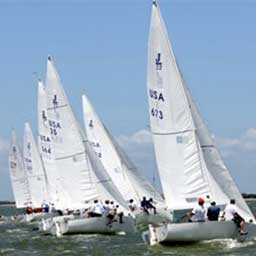Coastal Passage Making graduates will have successfully demonstrated their ability to responsibly skipper and crew an inboard auxiliary powered cruising sailboat during passages on coastal waters, in all weather conditions, including all levels of visibility and all hours of the day and night.
Recommended Equipment: It is recommended that Coastal Passage Making Certification courses and examinations be conducted on 30’ to 50’ sloop-rigged cruising keelboats with wheel steering and auxiliary diesel power, and with adequate equipment inventory to complete all required certification outcomes.
Prerequisites: The prerequisites for Coastal Passage Making Certification are both US Sailing Bareboat Cruising and Coastal Navigation Certifications.
Certification Requirements: Coastal Passage Making Certification requires the successful completion of the following knowledge and skill requirements. These requirements are expected to be performed safely with confident command of the boat, for a distance of at least 50 nautical miles upon coastal waters, with a wind speed of at least 15 knots, including an overnight passage.
Practical Skills
Preparation to Sail:
- Inspect the vessel for the proposed passage: hull, spars, deck, rigging, hardware, sails, engine, internal mechanical and electrical systems, head systems, freshwater systems, navigation systems, anchoring systems, galley and provisions, and stowage.
- Check the inventory, locate and inspect all required safety and emergency equipment, tools, and spare parts.
- Perform the correct lashing of the life raft or dinghy and other necessary equipment for deck stowage.
- Check the inventory of sails and their condition for the proposed passage, and justify your selection based on the expected sailing conditions.
Crew Operations and Skills:
- Demonstrate a comprehensive understanding of and correct operating procedures for Radar and GPS.
- Demonstrate a high level of seamanship skills.
- Demonstrate the ability to direct the crew and make decisions to benefit the passage goals in consideration of the weather and sea conditions, crew welfare, proper navigation, and safety.
Leaving the Dock or Mooring:
- Develop a departure plan for the vessel and crew, and demonstrate appropriate helmsman and crew coordination and skills for leaving the dock.
Boat Control in Confined Waters:
- Demonstrate boat control in close quarters in adverse conditions (actual or simulated) as you leave the harbor.
Navigation:
- Demonstrate the proper use of a thoroughly documented ship’s log.
- Demonstrate the use of tide and current tables.
- Demonstrate the use of the Light List and Coast Pilot.
- Plot danger bearings.
- Demonstrate the correct method of taking a running fix.
- Successfully navigate a passage of at least 10 miles without Radar or GPS.
- Successfully navigate a passage of at least 10 miles with Radar or GPS.
Boat Control in Open Water:
- Demonstrate leadership skills during a night passage.
- Demonstrate command and control of the vessel under all wind and sea conditions encountered during the passage.
- Demonstrate seamanship skills during a headsail change.
Heavy Weather Sailing:
- Demonstrate working on deck at night or under heavy weather conditions (actual or simulated) while using a safety harness and jacklines.
- Demonstrate the use of a boom preventer and explain how to overcome its inherent dangers.
Overboard Rescue Methods:
- Demonstrate both the Quick-Stop and Lifesling methods of overboard rescues, both day and night. Choose one of the above methods that is most appropriate for the current wind and sea conditions.
Safety and Emergency Procedures:
- Simulate a plan of action should your vessel be in danger due to fire, water intake, dismasting, steerage failure or other disasters. Demonstrate all safety considerations given the situation.
Anchoring Techniques:
- Demonstrate the ability to anchor or recover anchor while the vessel is under sail.
- Demonstrate the ability to properly execute a Mediterranean Mooring.
- Demonstrate the use of a tripline/anchor buoy.
Returning to the Dock:
- Develop an approach plan for the vessel and crew, and demonstrate appropriate helmsman and crew coordination and skills for returning to the dock.
Securing the Boat Properly:
- Coordinate the crew and demonstrate the stowing of equipment and cleaning of the vessel after returning to the dock.
- Check the vessel before leaving the dock: determine and report any required maintenance; check docklines, spring lines, and fenders; check through-hull valves, electrical system, bilge pumps, and overall security of the boat.
Knowledge
Preparation to Sail:
- Develop a detailed passage plan to include weather forecasts, strategies and tactics for all potential conditions, and navigation strategies.
- Coordinate the crew with a watch schedule and responsibilities during the passage.
Weather Forecasting:
- Describe the progression of cloud formations, and the weather associated with each, for both a warm and a cold front.
- Describe the function of a barometer and barograph as they relate to weather forecasting.
- Explain how high and low-pressure systems are formed, why they generate wind, and how the wind is affected by geography.
- Describe the different factors responsible for both advection and radiation types of fog.
- Identify at least five sources for gathering accurate weather information.
Crew Operations and Skills:
- It is recommended that all candidates have current First Aid and CPR certifications.
- Demonstrate a comprehensive knowledge of onboard systems and their maintenance, types of distress flares, and the contents and stowage of an abandon-ship “grab bag”.
Navigation Rules, International-Inland:
- Be familiar with the application of all the Navigation Rules, International-Inland.
Boat Control in Open Water:
- Describe your concerns about and reactions to the following issues: breaking waves in inlets, shoals, bars and lee shores.
Heavy Weather Sailing:
- Describe the causes of and your concerns about dangerous and uncomfortable sea states.
Overboard Rescue Methods:
- Understand the procedures for overboard rescue in a larger cruising boat in coastal waters under all weather conditions. Understand the Quick-Stop and Lifesling-type overboard rescue methods under sail: constant visual contact with the person in water, communications, rescue plan, sequence of maneuvers, boat handling, course sailed, pickup approach, and coming alongside the person in water (or simulated object).
- Describe methods of getting a person in water back on deck after the vessel is stopped alongside.
- Explain when overboard rescue should be done under power.
Safety and Emergency Procedures:
- Describe emergency procedures in the event that your vessel has been holed by a submerged object.
- Explain the proper procedures for protection against lightning strikes.
- Describe the procedures involved in an air rescue operation.
- Understand the benefits and limitations of EPIRB’s, PLB’s and personal AIS transponders.
Anchoring Techniques:
- Describe an appropriate plan of action for anchoring under high wind conditions.
- Describe an anchor watch schedule and explain the watch’s responsibilities.
Returning to the Dock or Mooring:
- Describe the difficulties and procedures of returning to the dock in adverse conditions.






